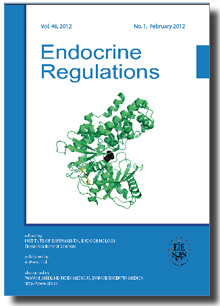Journal info
|
||
Select Journal
Journals
Bratislava Medical Journal Endocrine Regulations 2015 2014 2013 2012 2011 2010 2009 2008 2007 2006 2005 2004 2003 General Physiology and Biophysics Neoplasma Acta Virologica Studia Psychologica Cardiology Letters Psychológia a patopsych. dieťaťa Kovove Materialy-Metallic Materials Slovenská hudbaWebshop Cart
Your Cart is currently empty.
Info: Your browser does not accept cookies. To put products into your cart and purchase them you need to enable cookies.
Endocrine Regulations Vol.47, No.2, p.93–99, 2013 |
||
| Title: Ependymal cells variations in the central canal of the rat spinal cord filum terminale: an ultrastructural investigation | ||
| Author: A. Mitro, K. Gallatz, M. Palkovits, A. Kiss | ||
| Abstract: Objective. The ependymal cells, considered today as an active participant in neuroendocrine functions, were investigated by electron microscopy in the central canal of the lowest spinal cord, the filum terminale (FT), in adult rats. In this area of the spinal cord, the central canal is covered by a heterogeneous population of ependymal cells. The aim of the present work was to compare the regional features of the ependymal cells in two different parts of the FT with a special regard to their ultrastructure. Methods. Two parts of the FT were selected for the ultrastructural observations: the rostral (rFT) and the caudal (cFT) ones. The rTF was removed at the level of the immediate continuation of the conus medullaris, while the cFT 30 mm further caudally. After formaldehyde fixation, the spinal cord was removed and cut into small blocks for electron microscopic processing. The material was embedded into durcupan, contrasted with uranyl acetate, lead citrate as well as osmium tetroxide, and investigated under JEOL 1200 EX electron microscope. Results. In the rFT, the ependymal lining is pseudostratified and one-layered in the cFT, whereas the shape of the ependymal cells may vary from cuboidal to flatten in the rostro-caudal direction. The basal membrane of many ependymal cells possesses deep invaginations, so called “filum terminale labyrinths”. Many neuronal processes occur in the pericanalicular neuropil. In contrast to the rFT, the cFT is less rich in the neuropil particles. Some of the ependymal cells concurrently reach both the intracanalicular and extracanalicular cerebrospinal fluid (CSF), thus they may represent a new variant of the ependymal cells designated as “bridge cells of the FT”. Conclusions. The present data indicate that the FT ependymal cells exhibit clear differences in anatomy as well as ultrastructure that may reflect their distinct functional activity. Therefore, observations presented here may serve for the better understanding of the physiological role of the individual ependymal areas in this special portion of the rat spinal cord. |
||
| Keywords: ependyma, electron microscopy, spinal cord filum terminale, rat | ||
| Year: 2013, Volume: 47, Issue: 2 | Page From: 93, Page To: 99 | |
| doi:10.4149/endo_2013_02_93 |
||
|
Price:
14.00 €
|
||
|
|
||

